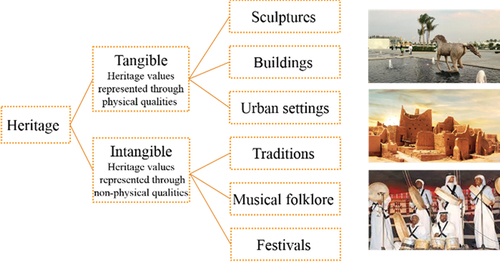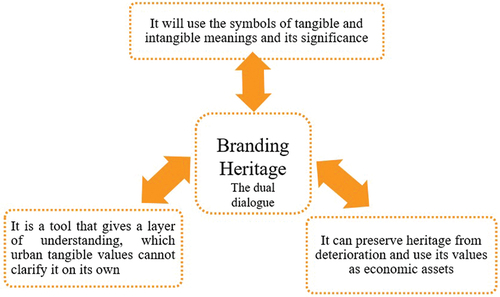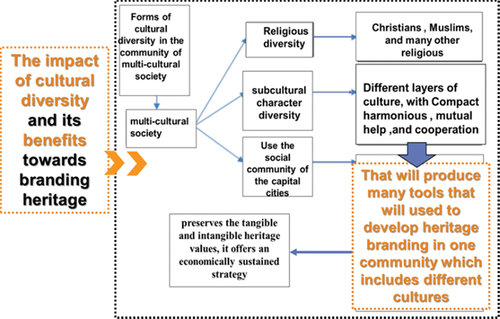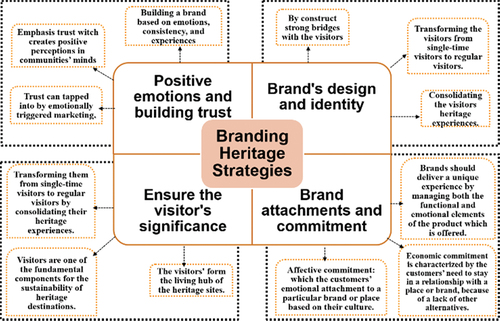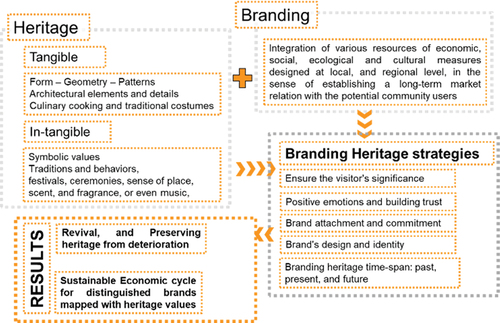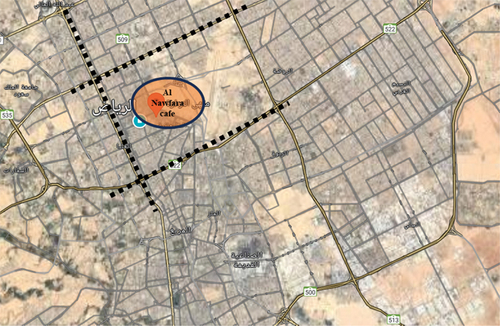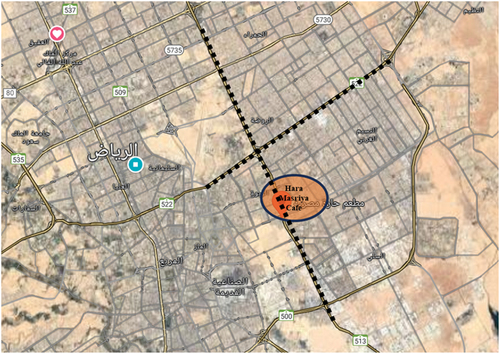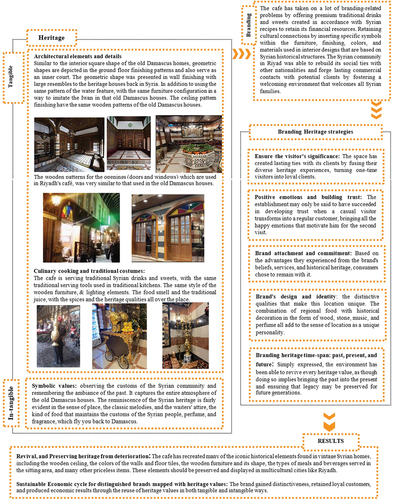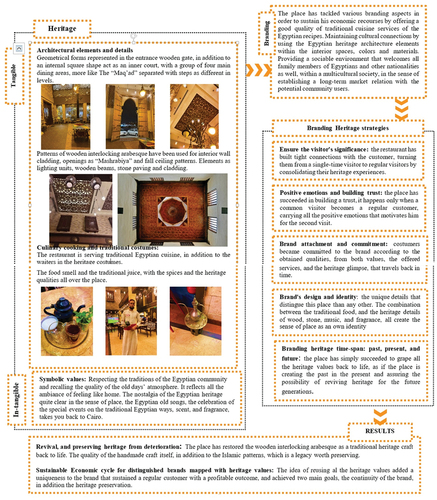ABSTRACT
Heritage is the platform of intangible attributes embedded within the physical urban values; it is the overlapping between urban forms and social history. Heritage can be a brand value proposition that creates a unique base of strong relationships between urban settings and users. The research is focusing on the idea of heritage preservation from a different perspective, adopting branding techniques and mechanisms to overlap the two disciplines in a study framework. Branding heritage re-introduces heritage values from the marketing perspective, in which the research reflects the idea of the place attachment and refreshes memories from the economic dimension. The research proposes a structural framework that accommodates the literature domains of heritage preservation as tangible elements, patterns, geometry … etc. and intangible values as spiritual, sense of place … etc. mapped with the branding approaches. The aim of this research is to trace the branding heritage tactics and examine the approach. The purpose is to preserve heritage from deterioration and use its values as economic assets. The research intends to validate the importance of marketing experience in branding heritage process, using the symbols of tangible and intangible meanings and its significance. The research anticipates studying marketing the heritage within multi-cultural societies, in terms of contributing the heritage of some urban setting within the heritage of others. The proposed structural framework reflects the mechanism of branding heritage. Finally, the research concludes its findings by offering interpretations of re-reading the users reflections and reviews to the concept of branding heritage upon an existing project setting.
Introduction
Heritage is that part of the present that was drawn from the past, which would be said that ‘a society’s identity is based on its heritage’. It is that combination of qualities from culture and traditions within an urban context. Heritage values reflect the place attachment and refresh memories created from layers of emotions. It embraces feelings that stand still even when the urban itself has been swept away [Citation1]. In that sense, heritage can be approached from the branding perspective, that provides distinctive relationships between the targeted community and the heritage values from the economic dimension. Branding heritage can tackle the glory of the past and the authenticity of the local values, within the dynamic movements of the modern diverse societies [Citation2]. The integration of multi-diverse heritage in the local development processes creates a place-branding strategy, especially in Mega multi-cultural cities [Citation3].
Literature review
The meaning of the word (Heritage) is quite broad, and it encompasses many aspects, part of our heritage is Tangible, as the built heritage which symbolize the people identity and history [Citation4]; aesthetic, archeological, symbolic values and historical architecture details refers to our inheritance. This built heritage has been passed down from one generation to the next. It is one of the fundamental essentials that constitutes the comprehensive memory and the cultural identity, which characterize society [Citation4].
On the other hand, the Intangible heritage is the expression of history through heritage qualities. It is recognized as a basic resource for asserting further development for cultural identity () [Citation5].
However, the role of heritage is not just to maintain and support cultural identity. In other words, heritage and its qualitative\quantitative elements can form a social constructive function for the cultural identity, in which heritage values can be represented through physical qualities such as buildings, monuments, districts, urban heritage villages, landscapes, sculptures, plans, books, motifs, paintings. In addition to nonphysical qualities as the musical traces, the distinguished cuisine, even the substantial events as feasts and festivals, all the memories which are related to certain community traditions behaviors, customs, beliefs … . etc., by appreciation the spirit of the place and its physical intangible components, in addition to the importance of adapting its local contexts with more conservation forms of heritage preservations.
Simply heritage is ordering values that organize the relation between human’s needs and their urban resources, which arrange their behaviors. Finally, it gives an image of different factors fuse, forming an identity of the urban setting through traditions and behaviors [Citation6].
Heritage; unlocking the potential values
Heritage is that combination of qualities from culture and traditions, learning from the past became an appreciated reason for conserving its values for the coming generations, as keeping the essence of the heritage of its uniqueness and locality [Citation4]. This heritage has been formed and developed through years of people’s communications and interactions, and it also has been formed by the interaction between human life and a specific urban context.
This socialization occurs within urban characteristics that define the relation between inhabitants and their surrounding urban context [Citation5]. Heritage creates a wave of harmony in which humans are trying to fulfill their needs through managing all the surrounding urban sources. Getting attached to urban heritage creates a unique sense of place. This is the reason why many civilizations, both in the developed and developing worlds, place a high value on heritage and take a great deal of care in maintaining its authenticity [Citation6].
Branding; marketing the identity
The idea of Branding is to establish a long-term relation with the potential community users by integrating various resources of local and regionally designed social, economic, and cultural initiatives connected to their character [Citation7]. Branding, moreover, may struggle in a massively competitive environment, where the community experiences great exposure to various brands daily [Citation8], that demands strong brand identities, elite product quality, and user attachments on high levels [Citation9]. In order to maintain a sustain brand, the academic literature about branding and users’ behavior has emphasized a proposal to attain the aim, by associating brand-specific features with community users’ aspirations to strengthen their local identity [Citation9].
Accordingly, the branding process is preferred to rely more on the local and authentic values. Place branding is a strategy that establishes deeply rooted connections, embraces the target community’s perceptions and heritage [Citation8]. This strategy usually tackles the visual, verbal, and behavioral representations that are strongly related to inherited values, within the market scope, the brand’s owner viewpoint, and their cultural backgrounds [Citation9].
From this perspective, branding heritage seemed to offer an efficient platform that provides all the aspired goals, it preserves the tangible and intangible heritage values, it offers an economically sustained strategy, and in addition, it secures a remarkable position for these brands away from the scary competitive environments [Citation10]. Branding heritage is a tool of displaying heritage from the economic dimension. Introducing heritage values from the marketing perspective to preserve its assets and to promote its significance [Citation11]. The conceptual perspective of brand heritage would be the growing fascination with authentic brands creating nostalgic feelings, from layers of emotions, not only its tangible qualities but the memories that it preserves [Citation12].
Branding heritage; the dual dialogues
The literature definitions of branding heritage are still considered relatively newly born interpretations. From the conceptual perspective, mapping the branding strategies and the heritage aspects – This dual dialogue – is quite unusual [Citation13]. The created dialogue is about the growing fascination with nostalgia and how to market these authentic values, aiming to preserve them, by compiling with the branding process [Citation14] and the literature argues that symbolic and emotional attachment between brands and users gives an opportunity to the brand to display heritage and create a proper connection between heritage authenticity within new multi-culture communities [Citation11].
Saving the hidden values of heritage aspects may be a way of securing identity, as unlocking the potential for the sake of the coming generations [Citation12]. Accordingly, the research adopted the ‘Branding heritage’ defined as ‘the multi-dimensional structure, composed of functional, rational, emotional, relational and strategic essentials that collectively generate a unique set of associations in the public mind’()[Citation13]. However, it is not easy to market very significant and deep values as heritage, as it directly reflects people’s character and is connected to their identity [Citation14]. The challenge for marketing is to brand heritage in a way that highlights its historical reliability, without appearing old-fashioned. Eventually, branding heritage is a tool to attach the brand in the minds of the community, keeping memories preserved, and saving the fading identity, this approaches a sustainable economic cycle that guarantees a well-income to the brand’s owner – seeking to distinguish their propositions in the market – in parallel with reviving heritage [Citation12]. Nevertheless, heritage values are hardly discoursed in academic literature on marketing base, excepting few references that refer to authentic heritage as national values at its homeland [Citation11]. However, this research goes far beyond branding heritage in its country of origin, on the contrary, the focus is to trace the heritage of some countries in other multi-diverse communities as target markets, in terms of contributing the heritage of some urban setting within the heritage of others [Citation13]. The fundamental idea of branding heritage is to demonstrate the key features of the heritage destination and to develop the site identity overtime in the user’s mental image and perspectives [Citation14].
Branding heritage in international markets; diversity of multi-cultural societies
Referring to the academic literature for the behavioral cultural mapping, there are numerous variances in value significances between community members within a nominated national group compared to individuals in other national groups, despite they still might share the same multi-cultural society [Citation15]. Just as countries have cultures, local communities within these countries also have different cultures, which may be similar in general, but there are certain details that appear and define the cultural features of this or that region [Citation4]. Every society is the product of its culture of language, religion, philosophy, etiquette, customs, traditions, folk traditions, customs, arts, and administrative and economic life systems, and as there are differences, there is similarity [Citation6].
Simply, each group shares a deeply rooted connection to its heritage, strongly inherited values, and travel with them as baggage to multi-diverse destinations [Citation1].
As a multi-cultural society, its challenge is to offer an opportunity to each national group to practice their various heritage behavioral attitudes, their own values, without being disturbed or discriminated against, but rather accepted. Not just that, in addition, it allows various national groups to share others with their cultural heritage behavior and experiencing new dimensions [Citation4]. Cultural diversity promotes progress as a scheme of living a full intellectual, emotive, moral, and passionate life and foster to create dialogue between diverse nations and cultures and hence attaining mutual respect and understanding among multiple societies [Citation9]. Including the arts, literature, and ways of living, value systems, beliefs, and traditions. As the research is relating the heritage values with the culture heritage behavior, accordingly, it is time to differentiate between tangible heritages as values related to physical meanings, as architectural details, styles, or even culinary cooking and traditional costumes. However, on the other hand, intangible heritage is more oriented to nonphysical expressions, as traditions, behaviors, festivals, ceremonies, sense of place, scent, and fragrance, or even a piece of music, somethings that you cannot touch, you just feel it [Citation6]. Just as countries have cultures, local communities within these countries also have different cultures, which may be similar in general, but there are certain details that appear and define the cultural features of this or that region ()[Citation4].
2.5. Branding heritage mechanisms and strategies
Approaching branding very delicate and sensitive values as heritage is quite a challenge. Branding Heritage entails integrations of aspects, as economic, social, religious, ecological, and cultural measures, generated on a local level, and captured to travel as ambassadors form their origins to fit in others’ heritage, as shown in () [Citation16]. This process mainly depends on the identity of the heritage, and its strong locality that will be adopted elsewhere and still preserve its originality. And to aspire to an effective process, branding narratives for heritage ought to be constructed on authentic values associated with solid sense of locality, to establish a rooted connection with the genuine new multi-diverse societies [Citation17]. The academic literature refers to the branding heritage strategies as follows ():
Table 1. Branding heritage: strategies interpretations.
Method
The research methodology focuses on promoting the branding heritage in space and time, not only its tangible qualities, but the memories that it preserves. Pursuing to comprehend the mechanisms of these strategic resources that stimuluses the relationships between the urban users and the offered brands.
The research introduces a structural framework for mapping the branding processes with the heritage values. It generates a seemingly valuable tool for understanding the branding heritage in the international markets within multi-cultural societies.
The research applies the proposed structural framework to examine two ventures in Riyadh, KSA. Tackling the adopted approaches to promote the multi-cultural heritage from the marketing perspective, and how this multi-diverse society accepts the branding of any other Arab or international heritage within its urban and cultural context [Citation25].
Research hypothesis
The research hypothesis is tackling the value of heritage preservation from a different perspective (the branding approach), as the research problem concerned with all the deterioration and destruction that heritage tangible and intangible values are facing, while responding to the research questions of how to preserve heritage using the branding strategies, and how to promote these values within other communities of multi-cultural societies. The research is proposing the structural framework as a comprehensive tool merging the multidisciplinary domains targeting to approach the research goals. The hypothesis elaborates the significance of introducing heritage elements of other countries within a multi-cultural platform as the Riyadh city, the idea is to preserve the heritage values in the heart and mind of the perceiver, to keep them in the memory even if their physical existence has been deteriorated or swept away, introduce them to other nationalities, that might not have heard about it. Keeping the history livable for the generations that have been born and raised away from their origins (Syrian kids born in Riyadh never been to their home country with limited chances to visit)
The structural framework
The structural framework is a conceptual outline for branding heritage as a proposed tool for enhancing and understanding the idea to preserve the tangible and intangible heritage and offer an economically sustainable branding strategy.
The framework consists of two main domains. The heritage domain investigates the tangible variables as form, geometry, patterns, and even traditional costumes and culinary cooking as a physical value that can be easily traced. In addition to intangible variables as scent, fragrances, ceremonies, that formulate the sense of place, more oriented toward nonphysical values that can be felt and experienced [Citation26].
The second domain represents the branding approach, definition, and understanding from the research perspective. The combination of the two domains creates the core of this research, which is the branding heritage strategies, in other words, the applied techniques to market the authentic heritage values.
The outcome of the structural model focuses on the aim of reviving and preserving heritage from deterioration, in addition to sustaining an economic cycle for distinguished brands mapped with heritage values [Citation27].
The research methodology adopted the qualitative method. It involved research observations and the use of series interviews with various members by conducting groups and individual interviews (). The idea of engaging the community as clients, visitors, and consumers is crucial for the market study. A sample of 746 interviews were applied from different nationalities, age groups, and gender, within a duration of six months. The interviewees were on a random selection, families, and individuals. Interviews were distributed between weekdays, weekends, three timings during the day (morning from 10:00 to 12:00), (afternoon from 1:00 to 5:00) and (evening from 6:00 to 10:00), with an interval of Summer (July – August), Winter (October – November) and Spring (March – April). Data were gathered from the literature, directed by the observation and the interviews, and reflected using the structural framework.
Research study areas
The proposed structural framework was conducted to study two ventures in Riyadh, KSA. Examining the marketing strategies used to promote the diversity of cultures and how this multicultural society embraces the branding of Egyptian, and Syrian foreign heritage within its urban and cultural setting. The case studies are an interpretation of re-reading the users reflections and reviews to the concept of branding heritage upon an existing project setting. The Kingdom of Saudi Arabia (KSA) is regarded as having a cosmopolitan society. Due to the free movement of traders and pilgrims throughout Saudi history, the Arabian Peninsula saw ethical and environmental diversity as well as cross-cultural exchange [Citation28]. Saudi Arabia is known for its multiculturalism, which is built on the coexistence of many diverse ethnic or national cultures. A multicultural society of Muslim Arabs and many other groups who moved to the country in search of employment and brought their own cultures and languages.
The population of KSA is diverse in terms of gender, ethnicity, class, and country of origin. Over 35 million people make up this population, including foreigners. Ten million non-Saudis are thought to reside in the nation overall. Syrians fleeing the civil crisis make up over a quarter of this population. Nearly 2.5 million Syrians reside in Saudi Arabia, where they are provided free access to healthcare and education and are encouraged to work there. They represent the largest sector of expats in the country. The second largest Arab expats population are the Egyptians, with a 1 million population. They represent employment opportunities in various fields. The food-service industry considered as the largest sectors for the Syrian and the Egyptians expats working opportunities [Citation29].
The most significant impact on trade and investment has been made by these arriving groups of various classes on numerous stages of KSA’s economic development. One of the most significant factors that stimulates the investment climate is the foodservice business, which is comprised of the three categories of restaurants, fast food restaurants, and cafes [Citation30]. KSA has placed a strong emphasis on turning the economic development wheel in line with its 2030 strategy. The facilities affiliated with the foodservice industry constitute an important element in the urban fabric of the city of Riyadh. The business accommodated the foreign investment procedures at all levels [Citation31].
Restaurants and café have evolved into a crucial element because they have long been thought of as a public activity and facility that people use for leisure and recreation. Nowadays, cafes play a much broader role than simply being a location where people go to enjoy drinks and amusement. They also play an important social and cultural part in the development of Arab personalities of many nationalities. It caused it to become ingrained in the public memory of its visitors [Citation31].
Within this context, the research will examine the efforts made by some residents who have invested in the food service industry to brand and transfer aspects of their origin tangible and intangible heritage, culture, and history using symbols and finishing materials from their heritage in the interior spaces of numerous restaurants and cafes that they have purchased in Riyadh. Two examples will be discussed within the case studies. The criteria for selection relied on the percentage in population and most employments from the Syrians and the Egyptians in the food serving industry.
Inspirations of the old Damascene houses: Al Nawfara cafe in Riyadh
The Al Nawfara cafe in Riyadh was founded in response to the Syrian refugee crisis and Syrian war-related migration dilemma. Refugees were dispersed throughout the Arabian countries; some of them chose to settle in Riyadh, a global city with a diverse population, and made it their permanent home. They started to establish businesses with economic income as a way of living. The place is located at Abdullah Ibn Riwaha Street, As Sulaymaniyah district, Riyadh capital (). The design attempted to replicate a historic café in the center of the ancient city of Damascus, which is thought to be one of the oldest cafés in Damascus. The place combines Syrian architectural elements. Modern construction methods and traditional features are combined to enhance the synthesis of styles, keeping a connection to Syrians’ heritage.
The study supports the significance of using the heritage vocabulary that creates a connection between the brand and the customers. The place shows the Syrian culture in a cosmopolitan setting like Riyadh. clarifies the key tenets of the framework that was previously discussed in the methodology and how it was adopted as a tool for reflections and reviews. It portrays the traditional elements that have been captured in the case study in Riyadh inspired by those in old houses in Damascus in order to brand the key characteristics of that cultural heritage.
Inspirations of the old Cairo houses: Hara Masriya cafe in Riyadh
The place was established in 2016 and has been growing for the past seven years. It is located at the Eastern Ring Branch Rd, Exit 15, Riyadh (). The place is representing the Egyptian heritage in terms of the interior design details, vocabulary of the walls and ceiling finishing. In addition to the food serving, music playing, and the ambiance of the old Cairo houses. The study validates the value of utilizing heritage values that constructs a relationship between the brand and its customers. The clarifies the key principles of the framework with how it was used as a tool for analysis and study. In order to represent the salient features of that cultural heritage, it depicts the traditional aspects that were seen in the case study in Riyadh and were inspired by those in historic houses in Cairo.
Branding heritage and its contribution in the preservation of cultural heritages
The word heritage is generally associated with inheritance: something transferred from one generation to another. As a concept, therefore, it works as a carrier of historical values from the past, having a heritage does not in itself create value but it may constitute the foundation of brand building, Brand heritage should be. Adopted in an international context. In order to maximize its use, it is necessary to know how strong it and the target country’s cultural heritage are. Branding heritage is a mixture of the history as well as the consistency and continuity of core values, and visual symbols, of any cultural heritage, it refers to the physical and emotional benefits that consumers receive from Branding heritage tools support cultural heritage and they both act together as a marketing driver to enable a country’s heritage preservation, by extension of the scope of branding to the societal level and expanding the area of branding applicability from economic to social, and from individuals to nations. Branding approaches and strategies would not only be welcome, but even necessary in the field of cultural heritage developments and its preservation that gives the chance to ensure its importance and reconsidering the role of cultural heritage, especially in multicultural societies. Branding heritage provide a tool that help in preserving cultural heritages, because it can explore the local cultural features, and the main important elements in any cultural heritage and identifying the prominent features at any heritage, then finding ways to introduce these essential components to other communities, so that can contribute to the preservation of that cultural heritage from degradation and destruction.
Results and discussion
Heritage as the unique identity for a local community serves as its distinctive character and functions as an ambassador, traveling beyond its place of origin to represent the traditions and beliefs of its nation in other lands and contexts.
The research combined the concept of branding as a means of achieving two main goals: first, to revive and preserve this heritage (tangible and intangible) from deterioration; and second, to sustain an economic cycle based on profitable values and reliable incomes by mapping the market values with the genuine heritage. Branding heritage meets both the economic aims and the authentic heritage revivalism in a single action. Using heritage values to forge deep ties with customers, achieves financial targets in addition to the cherished heritage preservation.
Reviving heritage in the first case (Inspirations of the old Damascene houses: Al Nawfara cafe in Riyadh) plays a double role, from the heritage perspective, the idea is to preserve specifically the Syrian heritage and the old Damascene houses, as the original ones are suffering from deterioration and drastic damage since the war crisis. From the economic perspective, individuals compelled to flee their country in pursuit of a reliable income to maintain their family, the food service sector offered a lucrative source of revenue. From the social perspective, offering such places that mimic the feeling of home, gives the sense of connection with their origins, and serves as hubs for gatherings reminiscent of the good old days back home, for all the Syrians who had to immigrate their own land and yearn for old memories, with hearts full of homesickness. The motivation to keep surviving is that one day we all be back and rebuild what was once the glories heritage.
Regarding the second case study (Inspirations of the old Cairo houses: Al Hara Masriya, Riyadh), it represents a successful example of a flourishing business relying on heritage as an asset to market the offered product. The place creates a unique experience for both Egyptians and the Saudi community. It gives the impression as if you are in Cairo. From the heritage perspective, it plays a significant role in marking the Egyptian authentic culture and heritage, to encourage all its customers to consider visiting Egypt, and promotes the touristic trips. From the economic perspective, it offers job opportunities for Egyptians living in KSA. From the social perspective providing spaces that replicate a sense of familiarity, and a gathering node for groups and families.
Both cases have represented the idea of branding heritage from different dimensions, though, both have approached the main goals of the research. The Syrian case study used the marking as a tool to preserve the deteriorated heritage due to the war crisis. However, the Egyptian case study used the heritage branding as a marketing strategy to promote tourism.
Conclusion
The study has followed the literature to develop the structural framework, the research concludes its findings by embracing the significance of reviving the heritage within the new perspective of branding and marking, as a tool to be economically sustained and well preserved. The findings also provide insights regarding multicultural societies. The results demonstrate the argument that branding heritage is a tool that gives a layer of understanding, which urban tangible values cannot clarify on their own. Mapping the urban users and branding heritage relies on the self-reinforcing elements of place attachments and building trust. It formulates a conceptual paradigm that memories stay alive through the intangible heritage, even after the original urban forms have deteriorated, and their glory days faded away. The research also presents empirical implications and offers recommendations for future research.
Acknowledgments
The authors declare that they have no known competing financial interests or personal relationships that could have appeared to influence the work reported in this paper. This research received no specific grant from any funding agency in the public, commercial, or not-for-profit sectors.
Disclosure statement
No potential conflict of interest was reported by the author(s).
References
- UNESCO World Report, 2009. Cultural heritage. UNESCO institute for statistics. “UNESCO framework for cultural statistics.”. [Online]available: The 2009 UNESCO Framework For Cultural Statistics (FCS) - UNESCO Digital Library Last Accessed28-9–2023
- Guzijan J, “Building heritage as an important factor of city branding.” Proceeding of International conference on Contemporary Theory and Practice in Construction XIII, 2018, p313–321. 10.7251/STP1813313G Last accessed,28-9-2023
- Yusdani R. Indonesia, Islam, and multicultural citizenship. Multicultural religious understanding between violence and resolution. J Rel Stud. 2018;18(1):1–14. Last accessed,28-9-2023. doi: 10.20885/millah.vol18.iss1.art1
- Ahmad Taha MN. Cultural heritage and contemporary armed conflicts in the Arab World. Conservation Archit Heritage Part Of The Book Series: Adv In Sci, Technol & Innova Springer. 2022. Last accessed28-9-2023. ISBN-978-3-030-74481-6. 10.1007/978-3-030-74482-3_15
- Ashour S. Rebranding Cairo’s downtown cinemas: “can performances resurrect abundant heritage? J Eng And Appl Sci JEAS, ISSN 1110-1903 - E-ISSN: 2536-9512, Fac Of Eng –Cairo Univ. 2019;66:No.3. Last accessed,1-10-2023.
- Baker W. The cultural heritage of Arabs, Islam, and the Middle East. ISBN- Publisher Brown Books. USA13: 2003; 978–0972957809. https://www.worldcat.org/title/The-cultural-heritage-of-Arabs-Islam-and-the-Middle-East/oclc/52854628. Last accessed 110-2023
- Aaker DA, “Building strong brands.” Free Press, New York, pp. 380. Publisher Simon & Schuster Book. (1996). https://www.academia.edu/34383247/David_A_Aaker_Building_Strong_Brands Last accessed,1-10-2023.
- Clifton R, Simmons J. Brands and branding. Last accessed 1-10-2023. Brands_And_Branding_-_Rita_Clifton_And_John_Simmons.pdf (culturaldiplomacy.org. Princeton, NJ: Bloomberg Press, 2009:pp. 27–45.
- Banerjee S. Strategic brand-culture fit: “A conceptual framework for brand management. J Brand Manage. 2008;15(5):312–321. Doi:10.1057/palgrave.bm.2550098 Last accessed 1-10-2023. doi: 10.1057/palgrave.bm.2550098
- Hakala U, Lätti S, B. Sandberg operationalizing brand heritage and cultural heritage. J Prod & Brand Manage. 2011 [Accessed 27 June 2022];20(6):447–456. doi: 10.1108/10610421111166595
- Fournier S, Alvarez C. How brands acquire cultural meaning. Journal Of Consum Psychol. 2019;29(3):519–534. Last accessed 1-10-2023. doi: 10.1002/jcpy.1119
- Ulldemolins JR. Culture and authenticity in urban regeneration processes: place branding in central Barcelona. Last accessed 1-10-2023 Urban Stud. 2014;51(14):3026–3045. doi: 10.1177/0042098013515762
- Ashowrth JG, Kavaratzis M. Beyond the logo: brand management for cities. Last accessed 1-10-2023 J Brand Manage. 2009;16(8):520–532. doi: 10.1057/palgrave.bm.2550133
- Rose GM, Merchant A, Orth UR, et al. Emphasizing brand heritage: does it work? And how. J Bus Res. 2016;69(2):936–943. Last accessed 1-10-2023. doi: 10.1016/j.jbusres.2015.06.021
- UNESCO World Report. “Investing in cultural diversity and intercultural dialogue”. Published in 2009 by the united nations educational, cultural and scientific organization. ISBN 978-92-3-104077-1. unesdoc.unesco.org/ark:/48223/pf0000184755 Last accessed 1-10-2023.
- Mihalis K, Ashworth GJ. City branding: an effective assertion of identity or a transitory marketing trick? Last accessed 1-10-2023. 2005;96(5):506–514. DOI:10.1111/j.1467-9663.2005.00482.x
- Popescu RI. The branding potential of Bucharest: strategy and success factors. Theoretical and empirical research in urban management. 2009;4(13): 177–193. Last accessed 1-10-2023: https://econpapers.repec.org/scripts/redir.pf?u=https%3A%2F%2Fum.ase.ro%2Fno13%2F12.pdf;h=repec:rom:terumm:v:4:y:2009:i:13:p:177-193
- Botschen G, Promberger K, Bernhart J. Brand-driven identity development of places.J Place Manage Dev. 2017 [Last accessed 1-10-2023];10(2):152–172. DOI:10.1108/JPMD-07-2016-0051.
- Morgan RM, Hunt SD. The commitment-trust theory of relationship marketing.J Marketing. 1994 [Last accessed28-9-2023];58(3):20–38. DOI:https://doi.org/10.1177/002224299405800302.
- Fullerton G. When does commitment lead to loyalty?J Serv Res. 2003 [Last accessed28-9-2023];5(4):333–344. DOI:10.1177/1094670503005004005.
- Fullerton G. The impact of brand commitment on loyalty to retail service brands. Can J Admin Sci. 2005 [Last accessed 1-10-2023];22(2):97–110. doi: 10.1111/j.1936-4490.2005.tb00712.x
- Ballantyne R, Warren A, Nobbs K. The evolution of brand choice.J Brand Manage. 2006 [Last accessed 1-10-2023];13(4/5):339–352. DOI:10.1057/palgrave.bm.2540276.
- Schmit B H, Zarantonello JJ, Brakus L. Brand experience: what is it? How is it measured? Does it affect loyalty? 2009. [Last accessed 1-10-2023]. University of Leeds. UK J Marketing. 73(3):52–68. 10.1509/jmkg.73.3.052.
- Thomson M, MacInnis DJ, Park W. Les liens attachants: mesurer la force de l’attachement émotionnel des consommateur à la marque. Recherche Et Appl En Mark. 2005 [Last accessed 1-10-2023];20(1):79–98. doi: 10.1177/076737010502000105
- Brown S, Kozinets RV, Sherry JF. Teaching old brands new tricks: retro branding and the revival of brand meaning.Journal Of Marketing query. 2003 [Last accessed 1-10-2023];67(3):19–33. DOI:10.1509/jmkg.67.3.19.18657.
- Berry LL, Carbone LP, Haeckel SH. Managing the total customer experience. MIT. Last accessed 1-10-2023 2002;43:85–89. https://api.semanticscholar.org/CorpusID:155546727
- Haeckel SH, Carbone LP, Berry LL. How to lead the customer experience. Mark Manage. 2003 Last accessed 1-10-2023;12(1):18–23.
- Al-Rakeiba AS. 'Movement and Transport of Pilgrims in the Hajj Region, Saudi Arabia' thesis, Department of Geography The University of Durham, England. August 1991; 530. http://etheses.dur.ac.uk/1426/1/1426.pdf?
- General authority of statistics, statistical database population. https://www.stats.gov.sa Lastaccessed 8-10-2023.
- Bouznif M, AlMudbe M. A case study about accelerating expansion of restaurants industry in Saudi Arabia. Bus Manage And Strategy ISSN. 2018;99(1):173. doi: 10.5296/bms.v9i1.13283
- Morrison S, Crane FG. Building the service brand by creating and managing an emotional brand experience. J Brand Manage. 2007 [Last accessed 1-10-2023];14(5):410–421. doi: 10.1057/palgrave.bm.2550080

